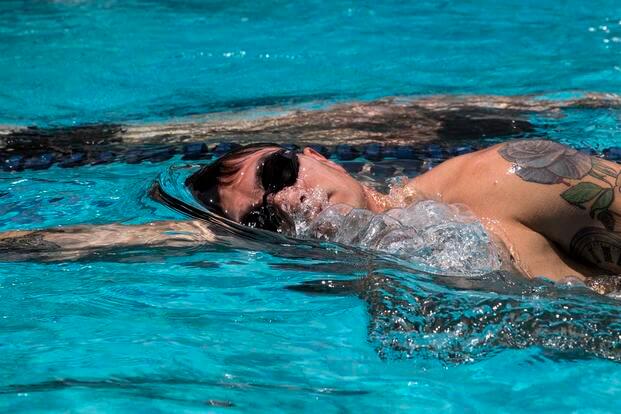When preparing for fitness tests, such as the Navy Special Warfare/Special Ops Physical Screening Test (PST) or the Air Force Special Warfare Initial Fitness Test (IFT), it is recommended to do workouts that will help you manage all three sections of the test. These sections will require swimming, running and calisthenics testing push-ups, sit-ups and pull-ups. Though both service branches have replaced crunches with the plank pose, the special units within these departments still test sit-ups.
Here is a typical upper-body day for candidates with varying testing performance levels to ensure future success on official testing events. Both tests are done during the delayed entry program or before attending special operations selection. If you do not meet the standards in these tests, your special ops journey ends for now.
Warm-up: Push-up/pull-up/half pyramid 1-10 (stop at 10/10), with 50-meter runs/dynamic stretching between each set.
This is a classic 55-rep warm-up, with jogging/dynamic stretches between sets. This typically takes 5-10 minutes. If you cannot do the entire half pyramid to Level 10, go up to five and repeat in reverse order. Warm-ups should be easy:
- 1 pull-up, 1 push-up, jog 50 meters
- 2 pull-ups, 2 push-ups, jog 50 meters
- Go up to 10/10, mixing in dynamic stretches as needed during the 50-meter jogs/walks.
Run one-mile warm-up: Depending on the running volume you are accustomed to, you can run a mile to complete the warm-up or do 10 minutes of biking or other nonimpact cardio.
Run goal pace: The goal of this circuit is to get you used to running and doing calisthenics together. If you are more advanced with your running and want to test your mile repeatability, go with a one-mile run at your goal test pace. This means that if you want a nine-minute, 1.5-mile timed run, you will want to do these one-mile runs in six minutes. If three sets of one-mile runs are too much, drop it to half a mile or quarter, but keep them at your goal pace. The rest is similar to testing, with two-minute rest periods between each calisthenics event.
Repeat three times.
- Run one mile (or 800 meters or 400 meters)
- Pull-ups max
- Push-ups max
- Sit-ups one minute at your goal two-minute pace.
Depending on the fitness test you take, you can rearrange the order of this workout to fit your testing order better. For instance, the PST requires the swim to be the first event, while the IFT has it as the final event. Here is the swim workout:
Swim 500-meter warm-up: The IFT is in meters, and the PST is in yards. Make sure you know the pool's length, as it makes about a minute's difference in your time if you mix up 500 meters with 500 yards. (450 meters = 500 yards.) It is recommended to start any swim with the actual test distance as your warm-up, as you can say during your PST when swimming is your first event: "This is my warmup." This will help you with the pre-testing anxiety that can occur. For the IFT, make the 500 meters your cooldown since it is last in your official test order.
The 50-50 workout: This classic swimming conditioning workout will quickly help any non-swimming athlete get into better swimming conditioning. This 1,000-meter swim will prepare you well for the 500-meter test.
Repeat 10 times.
- Swim 50 meters fast freestyle at 6-8 strokes per breath
- Swim 50 meters Combat Side Stroke (CSS)
- Minimum rest or tread as your rest
The goal is to get winded during the freestyle and catch your breath with the CSS, though you can also use the breaststroke or elementary sidestroke if you prefer.
This workout is not something you would do daily, but only a few times a week, as your other workouts can be focused on your legs with exercises such as squats and lunges and more running, rucking and/or swimming to continue the conditioning required to do well on these tests.
Stew Smith is a former Navy SEAL and fitness author certified as a Strength and Conditioning Specialist (CSCS) with the National Strength and Conditioning Association. Visit his Fitness eBook store if you're looking to start a workout program to create a healthy lifestyle. Send your fitness questions to stew@stewsmith.com.
Want to Learn More About Military Life?
Whether you're thinking of joining the military, looking for fitness and basic training tips, or keeping up with military life and benefits, Military.com has you covered. Subscribe to Military.com to have military news, updates and resources delivered directly to your inbox.




















